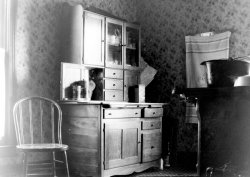
MAY CONTAIN NUTS

Search Shorpy
SHORPY ART

Framed or unframed, desk size to sofa size, printed by us in Arizona and Alabama since 2007. Explore now.
Join and Share
Ad-Free Shorpy
Shorpy is funded by you. Patreon contributors get an ad-free experience.
Learn more.

Recent comments
- Baldwin 62303
- Baldwin VO-1000
- Cold
- No expense spared
- Tough Guys
- Lost in Toyland
- And without gloves
- If I were a blindfolded time traveler
- Smoke Consumer Also Cooks
- Oh that stove!
- Possibly still there?
- What?!?
- $100 Reward
- Freeze Frame
- Texas Flyer wanted
- Just a Year Too Soon
- WWII -- Replacing men with women at the railroad crossing.
- Yes, Icing
- You kids drive me nuts!
- NOT An Easy Job
- I wonder
- Just add window boxes
- Icing Platform?
- Indiana Harbor Belt abides
- Freezing haze
- Corrections (for those who care)
- C&NW at Nelson
- Fallen Flags
- A dangerous job made worse
- Water Stop
Member Photos
The Shorpy
Print Emporium
Print Emporium
Search Shorpy
Search results -- 30 results per page
- The Tydol Twins: 1941
- ... Frank Lloyd Wright, as evidenced at a local museum here in Buffalo NY:
... realized until the directors of the Pierce Arrow Museum in Buffalo had his design built several years ago. This gas station is inside the ... Posted by Dave - 02/03/2019 - 4:04pm -
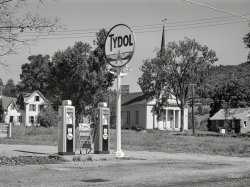
- S.S. Utica: 1910
- ... Utica, built in 1904 for the Western Transit Co. of Buffalo, N.Y. Gross tonnage: 3533, length: 325 ft., beam: 44 ft.
Hmmmm ... Posted by Dave - 08/14/2012 - 8:50pm -
![S.S. Utica: 1910 Circa 1910. "Freighter S.S. Utica, New York Central and Hudson River Railroad Line." 8x10 inch glass negative, Detroit Publishing Company. View full size.
1904-1949Constructed by the Detroit Ship Building Co., this 325-foot package freighter was launched April 28, 1904, at Wyandotte for the Western Transit Company, the marine operation of the New York Central on the Great Lakes.
In 1915 the Interstate Commerce Commission, citing the 1912 Panama Canal Act, ruled that American railroads could not also engage in marine transportation, and the NYC (as well as Erie, Pennsylvania, and Lehigh Valley) sold their steamship operations on the Great Lakes. Many of the vessels were consolidated under a new firm, Great Lakes Transit Corporation, for which the Utica ran from 1916 until 1945. That year, GLTC sold her to Chilean interests who renamed her Quintay. She was towed down the Chicago River, the Chicago Sanitary and Ship Canal, the Illinois River, and eventually the Mississippi to New Orleans.
The Quintay stranded and became a total loss on Penguin Island in the Messier Channel, Chile, on April 28, 1949, on a voyage from Callao to Punta Arenas while carrying general cargo and drums of oil.
Steamship Utica
Beeson's Marine Directory of the Northwestern Lakes, 1908
Steamship Utica, built in 1904 for the Western Transit Co. of Buffalo, N.Y. Gross tonnage: 3533, length: 325 ft., beam: 44 ft.
HmmmmI wonder what the three planks on the side of the hull are.
[Docking fenders. - Dave]
Rounding the Eastern Continent?I was not aware a vessel of this size could move South out of Lake Michigan and down thru to New Orleans in the canal/river system.
[As noted below, the Utica was a Great Lakes freighter. - Dave]
(The Gallery, Boats & Bridges, DPC)](https://www.shorpy.com/files/images/4a16007a.thumbnail.jpg)
- Parlor Portrait: 1914
- ... Electricity, even in the so-called "City of Light" that Buffalo claimed to be, was so expensive that only the wealthy could afford it until the late 1920s. Buffalo rates in 1910 translate to $2.40 per meter click, compared to my ... Posted by tterrace - 12/03/2016 - 9:16pm -
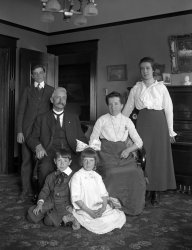
- Capitol Refining: 1925
- ... an independent concern, whose main establishment is in Buffalo, N.Y., and its announced that about September 1, after extensive ... Posted by Dave - 09/11/2011 - 6:42pm -
![Capitol Refining: 1925 A glimpse at the industrial side of Washington circa 1925, labeled "Capitol Refining Co. plant." This tank farm, where the Pentagon stands today, was described at the time as being in "Relee, Alexandria County, just south of the highway bridge." National Photo Co. Collection glass negative. View full size.
OMG!I hate it when Giant Amoebas attack!
Cattle, Cotton & Oil, Oh My!I find it curious how this site evolved from a stockyard and abattoir (slaughterhouse) into a cottonseed oil refinery and then finally the petroleum refinery pictured. The cotton-seed oil may have been used for food or industrial applications such as lubricants and paint. I wonder if equipment for refining cottonseeds could be reused to refine petroleum?
[Were any of these petroleum tanks? - Dave]
Update: After seeing the later White Dome post, I am pondering if perhaps the "refining" refers only to vegetable and animal oils and not to petroleum products at all. I guess its my fossil-fuel-centric lifestyle that led me to the conclusion that this was a petroleum refinery - that and pre-conditioning due to the long series of photos of service stations on Shorpy.
Washington Post, Jun 5, 1908
Packing Plant For City
Washington's industries are to be increased here of a plant with an annual output valued at from $4,000,000 to $5,000,000. The company, to be known as the Columbia Cotton Oil and Provisions Corporation, proposes to absorb the Washington and Virginia Stock Yard and Abattoir Company and to enlarge the plant and add equipment, not only for slaughtering of cattle, but for the refining of crude cottonseed oil.
...
The proposed plant, it is said, will be the only one of its kind east of Chicago and south of New York, and the only complete compound plant on the coast between New York and Savannah.
...
The annual capacity, according to figures submitted to the manufactures committee of the Chamber of Commerce, will be 100,000 barrels of crude cotton-seed oil, 125,000 hogs, 10,000 cattle, and 25,000 sheep and calves which will be converted into lard, lard compound, lard substitute, cooking oils, lard stearine, oleo stearine, hams, bacon, sausage, canned meats, fertilizer, hides, and a variety of fresh cuts to be put on the market.
Washington Post, Jun 2, 1913
Refiners Buy Oil Plant
The Capitol Refining Company, which was recently granted a charter by the Virginia corporation commission, has purchased the plant of the Columbia Cotton Oil and Provisions Corporation, at Relee, near Arlington Junction, Alexandria county. The Capitol Refining Company is a subsidiary of the Jacob Dold Packing Company, an independent concern, whose main establishment is in Buffalo, N.Y., and its announced that about September 1, after extensive repairs to the plant, operations will be resumed.
Relee, Va.Is it possible that Relee stands for Robert E. Lee? His estate was nearby.
[You are correct. The use of Relee, Virginia, as a place name seems to have begun in 1909, with the establishment there of a post office, rail stop and telegraph office, all connected with the Columbia slaughterhouse and rendering plant in what used to be Alexandria County, at the current location of the Pentagon. By 1935, use of the name seems to have pretty much stopped. - Dave]
Washington Post, November 11, 1909
Finishing Big Plant
$450,000 Abattoir and Refinery Soon to Operate.
To Employ 200 Persons. Industry at Arlington Junction Will Help Virginians.
Within ten days the Columbia Cotton Oil and Provision Company will begin operation of its $450,000 plant, which has been building near Arlington Junction across the river for the last nine months, and will mark one of the greatest strides forward in the industrial development of Washington.
In the abattoir 4,000 hogs a week will be killed, and a strong demand will at once be created in Virginia and surrounding States for porkers. ... The cotton oil refinery and abattoir will be run in conjunction in the production of lard compound, which will be one of the most important outputs of the establishment.
... The plant essays the importance of a town which has been recognized already by the establishment of a railroad stop and a postoffice by the United States government. The name is Relee, in honor of R.E. Lee. It is Relee postoffice, Relee station, and Relee telegraph office, all of which are in operation.
Day of JudgmentCould the "accidental" location of the "cloud" be any better placed in terms of composition? Actually makes the shot better, I think.
(The Gallery, D.C., Natl Photo, Railroads)](https://www.shorpy.com/files/images/32665u.thumbnail.jpg)
- Jackknife Bridge: 1907
- ... to research and write a song about the grain scoopers of Buffalo. Thanks, Shorpy.
(The Gallery, Boats & Bridges, Chicago, DPC, ... Posted by Dave - 08/09/2012 - 11:56pm -
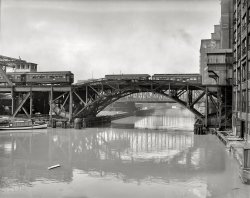
- All-American: 1942
- ... John Basilone, an Italian-American from New York, although Buffalo, would be awarded the Medal of Honor for his actions during the Battle ... Posted by Dave - 04/24/2013 - 9:30pm -
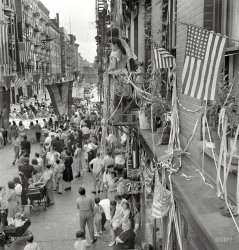
- Jumbo Bubble Birthday: 1959
- ... we used to cook pancakes. We used it until we left the Buffalo area in 1973.
I can hear the hummmmm The stove vents right ... Posted by MarkN - 07/28/2012 - 8:05pm -
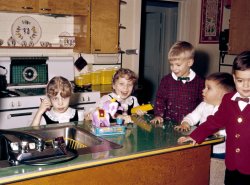
- Topside: 1912
- ... Detroit River.
Maiden voyage June 26, 1912. Detroit to Buffalo.
Sources: Loss of American Vessels Reported during 1913; Merchant ... Posted by Dave - 02/07/2013 - 2:09pm -
![Topside: 1912 Circa 1912. "Steamer City of Detroit III, hurricane deck." Note the partly submerged wreck at left. The D-III was one of the largest sidewheelers on the Great Lakes. 8x10 inch glass negative, Detroit Publishing. View full size.
Mystery Wreck SolvedIt is the steam screw Joseph C. Suit, built 1884, 318 gross tons. On May 30, 1912, the vessel collided with CITY OF DETROIT III, which was leaving the shipyard at foot of Orleans Street on sea trials on Windsor side of the Detroit River, and became a total loss. 11 persons on board; no lives lost. The vessel was later blown up to remove the wreck.
The City of Detroit III, designed by Frank E. Kirby, was the largest sidewheel steamer in the world:
Launched Oct. 7, 1911. 600 staterooms; speed of 23mph.
Trial run May 30, 1912. Collision with JOSEPH C. SUIT, sinking her on the Detroit River.
Maiden voyage June 26, 1912. Detroit to Buffalo.
Sources: Loss of American Vessels Reported during 1913; Merchant Vessel List of the United States, 1889.
Lifeboat numbersWere they odd/port, even/starboard?
What a ship!! 477 staterooms, 21 parlors, and a cocktail lounge/wine cellar that cost nealry a quarter of her total. Compare that to flying economy on Southwest.
Collision just happened?So, based on DrDetroit's post, was this picture taken immediately after the collision? If so, wow!
The paint on the deck seems too worn for this picture to have been taken on its trial run, although maybe it got worn simply from being outfitted, etc., and was scheduled to receive another coat prior to the maiden voyage.
Sign me up DaveSign me up for the maiden voyage in the Shorpy time machine.
What a great time to be had walking on these decks and later walking the NYC streets of the early twentieth century.
Joseph C. Suit?Comparing the photographs, it is clear that the sunken vessel is not the same ship as the image posted in the comments. The bridge on the sunken ship is smaller, the funnel is in not in the same place (or level) the front mast is not the same, and there is a deck below the bridge on the sunken ship with openings (dark in image) that does not exist on the comments photograph. Also. the upper deck overhangs the lower deck.
[Boats change. Wooden pilot houses and decks get rebuilt; boilers, funnels and masts get replaced. No doubt the Suit went through a number of alterations -- the vessel was almost 30 years old when it wrecked. - Dave]
It is the Joseph C. SuitHere is a snapshot taken from the deck of the City of Detroit III, just after the incident on 30 May 1912. The Suit had been rebuilt no fewer than four times during its life.
(The Gallery, Boats & Bridges, Detroit Photos, DPC)](https://www.shorpy.com/files/images/SHORPY_4a16206a.thumbnail.jpg)
- Duct Soup: 1908
- ... table appears to be for ice input. Got to keep the Buffalo steaks, or Detroit sausages, or whatever cold.
[Close-up. ... Posted by Dave - 07/17/2013 - 6:33am -
![Duct Soup: 1908 Circa 1908. "The galley. Steamer City of Cleveland, Detroit & Cleveland Navigation Co." 8x10 inch glass negative, Detroit Publishing Co. View full size.
It Took Some Time to Sink InAfter a week had passed, the galley crew finally realized that no matter how stolidly they worked, they were never going to be given any actual food to prepare.
Dave is . . .KING OF THE KAPTIONS - sometimes I can be a bit obtuse, but I did manage to get this one.
Crowd poisonThis ship's ventilation system may be oversized by modern standards. In the mid-19th century, carbon dioxide was proven non-toxic to humans, but experts remained wedded to the idea that we were exhaling some unknown toxin which made rooms with large numbers of people dangerous or unhealthful. This led to code requirements of 30 cfm per person of outside air, a staggering requirement by today's standards, making heating and cooling inefficient.
I don't know if these practices made their way into marine engineering, but I presume they did. In any case, a galley would have different requirements.
The "crowd poison" theory increasingly fell from favor after 1911, according to Chapter Three of Air Conditioning America by Gail Cooper.
Scrapped in 1956Click here for a short article and photo about the City of Cleveland III from the website of the Marine Historical Society of Detroit.
IceThe small door at the rear of the butchers table appears to be for ice input. Got to keep the Buffalo steaks, or Detroit sausages, or whatever cold.
[Close-up. -tterrace]
AnimatronicsIf you can find the slot for your token, they will all spring into action.
Coveting the cookwareI'll bet if you could find those pots and pans, they would still have plenty of use in them! I'd love to know what they used that huge, well designed, copper kettle for!
(The Gallery, Boats & Bridges, DPC, Kitchens etc.)](https://www.shorpy.com/files/images/SHORPY_4a15987a.thumbnail.jpg)
- Arlington: 1922
- ... was a segregated, African-American regiment, an original "Buffalo Soldier" unit that also fought alongside the Rough Riders in the ... Posted by Dave - 05/27/2013 - 1:41pm -
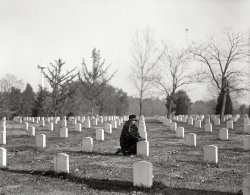
- Major Medical: 1920
- ... I concur. My ex-husband's grandmother served in WWI at the Buffalo Base Hospital, in Vittel, France. I admired her greatly and had the ... Posted by Dave - 08/28/2012 - 5:58pm -
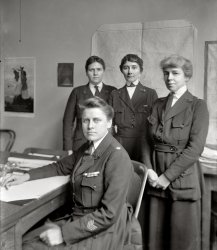
- Whirlpool Rapids: 1900
- ...
and others of downtown Buffalo include ads for the trolley car.
"Around the Gorge Summer Excursions ... Posted by Dave - 06/22/2016 - 11:02am -
![Whirlpool Rapids: 1900 Circa 1900. "Whirlpool Rapids from Niagara Railway bridge, Niagara Falls, N.Y." 8x10 inch dry plate glass negative, Detroit Publishing Company. View full size.
Great Gorge Route1895-1935; more a victim of the automobile & Great Depression than a rock slide.
What is the purpose of the little house on the lower left? It looks like some kind of enclosed elevator system. Then the wooden walkway goes to another little house just around the bend.
Judging by the different color in the walkway a boulder (now sitting by the river's edge) has come crashing down.
(Later) Thanks to a Shorpy inspired afternoon, I find the walkway along the left bank is still there today. It looks like it may have been modified a couple of times. It's called the White Water Walkway. A tourist photo op in Niagra Park. I wonder if the building almost out of sight is a resturant or inn?
It looks like all the tracks are gone from the right bank.
Sight seeing from the city?The train car appears to be a street car from local town on a sight seeing excursion? Is the covered shed for the switchman? I noticed a couple of cross over tracks there also.
Whatizit?OK, I know it isn't a third rail, but what is on the outside rail (closest to the river), on the curve of the track the trolley is on? I see another set of this on the next curve behind the trolley too.
FYI, I am not referring to the guard rail inside the gauge.
edit:
Finding more rail oddities now. The repetition of unknown boxes back by the crossover and station, again on the river side, on the wooden catenary support poles is strange. Why so many?
edit #2:
John and all, thanks for the info on the name and location of the photos. With that I found:
[url]http://upload.wikimedia.org/wikipedia/commons/2/28/Niagara_Gorge_Railroad.jpg[/url]
This photo clearly shows that 'third rail' as another type of guard rail for the event of a riverside derailment, it would hopefully keep the trucks from veering any further into the gorge. No insulators seen supporting it and confirmation of trolley pole fed power.
Around the GorgeThis link:
https://www.shorpy.com/node/8978?size=_original#caption
and others of downtown Buffalo include ads for the trolley car.
"Around the Gorge Summer Excursions 75 cents"
They did mean both sides of the Niagara River, the opposite side of the "Around" was on top of the other cliff, see the row of poles at upper left. Yes, it was an International streetcar line.
Postcard closeupsTwo of the three postcards shown here:
http://30squaresofontario.blogspot.ca/2012/01/niagara-falls-trolley-card...
might give a little more insight into track and trolleys.
Thanks for posting this picture. I haven't seen an overview of this trolley line before.
Some AnswersBilly B: That house on the left is the bottom entrance to the elevator for the Whitewater Walkway (been there several times) on the Canadian side and also a gift shop for tourists. It's still there and was even seen in the movie "Superman 2".
Billy B & MrK: Those tracks were part of an excursion line that ran along the bottom of the gorge on the American side. The line ceased operation about 1918 after a couple of rock falls wrecked the tracks. It ran from Lewiston NY south to about where the Whirlpool bridge is now. There was a turnaround and the passengers would ride back to Lewiston. The tracks were ripped out during the Depression.
(The Gallery, DPC, Railroads)](https://www.shorpy.com/files/images/SHORPY-4a19733a.thumbnail.jpg)
- Place d'Armes: 1916
- ... see on Shorpy, especially of cities such as Cleveland and Buffalo. A hundred years ago the cityscapes weren't that different. I would ... difference. In Montreal, they installed cobblestones; in Buffalo they built parking lots, and their former downtown is almost abandoned. ... Posted by Dave - 01/22/2018 - 9:37am -
![Place d'Armes: 1916 Circa 1916. "Place d'Armes and Notre Dame Cathedral, Montreal, Quebec." 8x10 inch dry plate glass negative, Detroit Publishing Company. View full size.
Place d'ArmesThe statue, lower center, erected in 1895, is of the founder of Montreal, Paul de Chomedey, Sieur de Maisonneuve. On the nearby Bank of Montreal is a plaque which reads: "Near this square afterwards named La Place d’Armes the founders of Ville-Marie first encountered the Iroquois whom they defeated, Paul de Chomedey de Maisonneuve killing the chief with his own hands. March 1644.” At the base of the monument itself is another plaque with a more shocking message by de Maisonneuve: "Il est de mon honneur d'accomplir ma mission. Tous les arbres de l'île de Montréal devraient-ils se changer en autant d'Iroquois." Which translates: "Upon my honour I am bound to accomplish my mission; even if all of Montreal’s trees should transform into as many Iroquois."
Great Old StuffThe building slightly visible on the extreme left -- you can just make out part of the clock tower -- was built by the New York Life Insurance Company in 1887 and at 8 floors was the tallest building in Montreal when it opened. The building next to Notre Dame is the Saint-Sulpice Seminary, part of which dates back to 1684. And in the middle of the square we find the statue of Paul Chomedy de Maisonneuve erected in 1895. All of these, and much more, are still there.
BasilicaAt the time it was built there weren't very many stone-carvers in Montréal, so the decoration is a bit plain. These days the cathedral is Mary, Queen of the World, which is a short distance away.
Radio or Lightning?Given the year, I am assuming the towers on top of the spires are lightning rods, not radio towers. Eh?
[Wireless telegraphy masts started being placed atop tall urban buildings before the turn of the century. -tterrace]
A striking differenceExcept for the addition of a small Art Deco highrise to the left and a massive 1960s block on the right, Place d'Armes has been preserved pretty well. But there's been one striking addition: the the concrete pavement of this photo has long since been replaced by cobblestones, in order to bolster the square's quaintness. Nowadays it's a cliche to rave at how "European" Place d'Armes looks.
It's a bit sad to contrast this view with some of the other photoscapes you see on Shorpy, especially of cities such as Cleveland and Buffalo. A hundred years ago the cityscapes weren't that different. I would argue that a lot of the American cities were even more fantastic than Place d'Armes. The trajectories of these cities echoed each other - although Montreal hasn't had the same economic trouble as the Midwest, this area of the city also fell into hard times and was pretty decrepit during the mid-century. But the revitalizers in the Midwest and Montreal had different ideas, and that's made the difference. In Montreal, they installed cobblestones; in Buffalo they built parking lots, and their former downtown is almost abandoned.
(The Gallery, DPC, Streetcars)](https://www.shorpy.com/files/images/SHORPY-4a24892a.thumbnail.jpg)
- Basting the Bird: 1937
- ... looking ovens. Looks like you could roast up a couple of buffalo in those things.
Not very safety-first Anything that involves ... Posted by Dave - 08/28/2012 - 5:28pm -
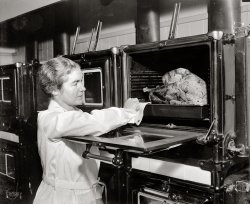
- Hotel Velvet: 1904
- ... that type of peanut/popcorn wagon from when I was a kid in Buffalo, NY. during the very early 1950s, I'd get a bag of popcorn from my mom ... Posted by Dave - 12/04/2012 - 8:24am -
![Hotel Velvet: 1904 Old Orchard, Maine, circa 1904. "Hotel Velvet from beach." Note photo studio signage at right. Renamed the Hotel Emerson, the place "burned like oil" in the Great Fire of 1907. 8x10 glass negative, Detroit Publishing Co. View full size.
Oh my goodness....I remember that type of peanut/popcorn wagon from when I was a kid in Buffalo, NY. during the very early 1950s, I'd get a bag of popcorn from my mom if I was good when we went downtown to go shopping.
Get yer red hotThe peanut or popcorn or salt water taffy wagon near the photo studio probably sold their wares for an outrageous nickel, much higher than non-resort stands. Wish I had that wagon today.
Old Glory?If you look at the roof of the cupola on the right side of the photo--the cupola without an American flag flying--it would appear that Old Glory has fallen from its flag pole and is now on the roof, draped at the foot of the pole. Is that observation correct?
[Seems to be. - tterrace]
Velvet KissesOn the corner of East Grand Ave. and Old Orchard Ave. in Old Orchard Beach. Hildreth's Velvet Kisses were put up and sold in yellow boxes at this location and were known to thousands.
Lady ZamoraOther Shorpy views of the Hotel Velvet and Lady Zamora's fortune-telling booth at Old Orchard Beach: 1904, and Hotel Velvet: 1904 (s2010).
WhimsyDescribes the style of architecture, perfect for a place you'd go to escape your cares and worries.
(The Gallery, DPC)](https://www.shorpy.com/files/images/SHORPY_4a17497a.thumbnail.jpg)
- Family Gathering: 1967
- ... apron. Mom is the second from the right. This was in Buffalo, New York. View full size.
Color correction I took a stab at ... that time?
No Subject Love the apron! Had a similar Buffalo holiday experience growing up! Are you drinking a Genny Cream?
... Posted by billybobtoo - 02/01/2011 - 10:37am -
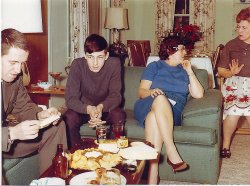
- Carousel: 1950
- ... Hope there's more!
Antique Carousels Here in Buffalo, we have two (or soon will). Both were built by the Herschel Co. in ... soon to be in place at the Canalside Park in downtown Buffalo. According to the news reports about them, there are currently 26 such ... Posted by Roachmotel - 10/13/2016 - 12:38pm -
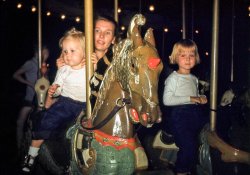
- Hello?
- ... here.
switchboard I think this might have been in Buffalo at the Central Terminal Train Station.
same stuff, different decade ... Posted by Dave - 09/07/2011 - 3:30pm -
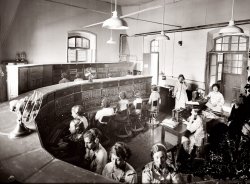
- Welcome, Wagon: 1919
- ...
Cross-Country Atterbury trucks were made in Buffalo, New York.
Automobile Row again Earle C. Anthony's REO and Dort ... Posted by Dave - 08/05/2016 - 9:57pm -
![Welcome, Wagon: 1919 San Francisco circa 1919. "Bus" is all it says on the sleeve of this 5x7 glass negative showing a motor home on an Atterbury truck chassis. In the Firestone display window, it's beginning to look a little like New Year's. View full size.
Mystery hardwareI can usually identify most components of early automobiles, but those vertical cylinders which appear to be attached to the forward end of the front springs have me baffled.
Some sort of primordial air suspension or shock absorber??
Shock absorbers, probably by Gruss, as seen and commented on in this photo. -tterrace]
Cross-CountryAtterbury trucks were made in Buffalo, New York.
Automobile Row againEarle C. Anthony's REO and Dort dealership was at 1400 Van Ness Ave., with Firestone Tire & Rubber (F.C. Flickinger, manager) next door at 1414.
San Francisco Planning Commission on 1400 Van Ness: "This is a fine restrained Classical Revival auto showroom with a rusticated base and Corinthian pilasters. The bay and pilaster width relate to the width of the street, with the Van Ness facade having a larger scale than the Bush facade. Because of the building’s corner location it would be difficult to alter or add to without significantly harming its integrity; therefore the building should remain intact."
The PalaceAlmost certainly, the gentleman standing just to the right of the driver's door is Arthur M. Neal (1869 - 1938) who built this traveling home for himself and his wife Fannie I. Neal (1871 - 1965). Having been the proprietor of the Hotel Arthur (1911-1912) and the Hotel Yale (1913 - 1919) in San Diego, he knew what accommodations were needed when traveling away from home. They nicknamed their vehicle "The Palace." The San Diego commercial automobile body firm of Klersy & Caldwell provided assistance with the build of the motorhome which was painted brown. Based on California vehicle registrations, the Atterbury was used by the New Southern Hotel as a bus prior to the Neal's ownership. It is likely a Model D built circa 1914.
Newspaper articles start appearing with photos of their mobile home in October, 1919, but the couple stated in the Roseburg [Oregon] Review, on October 3rd, that they had been on the road for eight months already. All of the earliest newspaper photos of their caravan do not show the Gruss shock absorbers installed, leading me to wonder if perhaps the Firestone dealer installed the devices for the Neal's. After visiting San Francisco their intent was to head east for a year.
The article below, from the magazine "Sunset," published in June 1920, describes more about their vehicle and the Neal's extended travels. This article is the last published piece I found about their excursion. The pair returned to San Diego later in 1920 or early 1921 where they became the managers of an apartment building at 1313 24th Street until Arthur Neal passed away in 1938. Fannie Neal continued residing there until just after WWII, but, even after leaving this apartment, she remained in San Diego for the rest of her life. She died at the age of 93 in 1965.
(The Gallery, Cars, Trucks, Buses, Chris Helin, San Francisco)](https://www.shorpy.com/files/images/SHORPY-1013.thumbnail.jpg)
- Some Assembly Required: 1906
- ... a more modern appearing freight carrier for John Boland of Buffalo. Less than a year after this photograph was taken, the Hill, ... Posted by Dave - 06/10/2013 - 1:16am -
![Some Assembly Required: 1906 1906. "Great Lakes Engineering Works, Ecorse, Michigan. Steamer James Laughlin at left." Now where'd I put that instruction sheet? View full size.
[Owner name here] ChallengerHull 17 is still sailing in steam. She's had many names. Launched Feb. 7, 1906 as William P. Snyder, later Elton Hoyt II, Alex D. Chisolm, Medusa Challenger, Southdown Challenger, and St. Mary's Challenger. Built as a traditional bulker, later converted to a specialized cement carrier.
She currently has a 4 cylinder Skinner Unaflow (or Uniflow) steam engine.
Note that many Great Lakes freighter names were reused on several different boats, thus if you try to look up a specific boat name, you need to check the dates that a boat carried the name. On the lakes, renaming apparently had no superstitious stigma.
They are bigger nowI just watched the 1014 foot long PAUL R TREGURTHA come into Duluth. Zounds, what a large ore boat!
Probably early winterThis is probably early winter 1906 at Ecorse, since the James Laughlin would be launched on April 6, GLEW's hull number 16 for Pittsburgh's Jones & Laughlin Steel Company and operated by its subsidiary, the Interstate Steamship Company of Duluth. Sold Canadian in 1964 and renamed Helen Evans for Captain Norman Reoch's Hindman Transportation Co., Ltd., of Owen Sound, Ontario, she was scrapped in 1981 at Cartagena, Colombia. The vessel to the right on the ways is almost certainly the Michigan, hull number 20, being constructed for the Grand Island Steamship Company, part of the Cleveland Cliffs Iron Company, which would launch on May 26. Also sold Canadian in 1965 and renamed Goudreau, she would last until 1969 when scrapped at Santander, Spain. The vessel to the far left is the Charles B. Hill of 1878, launched as the Delaware and previously featured on Shorpy, being rebuilt into a more modern appearing freight carrier for John Boland of Buffalo. Less than a year after this photograph was taken, the Hill, coal-laden and towing the barge Commodore, would be purposely run aground when her seams began to open during a gale on November 22, 1906. All crew survived. Her remains still exist in shallow water about a half mile offshore of North Madison, Ohio, west of Ashtabula, in Lake Erie.
Not their most famous shipTragedy (and subsequently, Gordon Lightfoot) cemented the SS Edmund Fitzgerald's status as GLEW's most famous ship. Launched in 1958, the Fitzgerald famously went down in high [inland!] seas on Lake Superior, November 10, 1975.
Here's a grim tidbit I learned only within the past decade. The lake's average temperature hovers around 40˚F. This temperature is cold enough to prevent gases from forming in corpses--gases that would, normally, cause a dead body to float to the surface. Thus, Lightfoot's lyrics are not merely poetic when they relate, "The lake, it is said, never gives up her dead."
(The Gallery, Boats & Bridges, DPC, Industry & Public Works)](https://www.shorpy.com/files/images/SHORPY_4a21308a.thumbnail.jpg)
- Chili in Cleveland: 1905
- ... on the Great Lakes have worthwhile marine museums, such as Buffalo (Navy ships), Erie (primarily early sail history, and the Battle Of ... Posted by Dave - 04/06/2016 - 8:53am -
![Chili in Cleveland: 1905 Lake Erie circa 1905. "Freighters Chili & Wm. Castle Rhodes at Cleveland." After half a century of service that included a number of sinkings, groundings and collisions, the Chili (renamed the Sarnian in 1913) was scrapped in 1944. 8x10 inch dry plate glass negative, Detroit Publishing Co. View full size.
The ChiliFrom the Great Lakes Maritime Database there is a clearer view of the vessel's name on the wheelhouse. However, the name on the stern still looks like "CHILL" in that pic. also.
[There's a period after the "I" -tterrace]
It's "THE CHILL"The tail on the 2nd "L" is obscured by the ladder.
[Chili. -tterrace]
Another Great Lakes vessel databaseThere is at least one other large Great Lakes vessel database. This other one is at Bowling Green State University (Ohio) They appear to complement each other. Their entry for the Chili.
The BGSU collection is open to researchers, and it is common for someone with interest in lake boats to spend a day or several days there.
Additionally, the marine museum that was in Vermilion OH has moved to Toledo, and includes exhibits and a very nice restored lake boat (ie a large freighter) to tour.
Many ports on the Great Lakes have worthwhile marine museums, such as Buffalo (Navy ships), Erie (primarily early sail history, and the Battle Of Lake Erie), Ashtabula + Fairport Lighthouse (lake freighter photos + artifacts), Duluth (a lake boat to tour), etc.
(The Gallery, Boats & Bridges, Cleveland, DPC)](https://www.shorpy.com/files/images/SHORPY-4a25401a.thumbnail.jpg)
- Steichen Autochromes
- ... story of how they recently made their way from a house in Buffalo, where they apparently sat unseen for decades, to the collection of the ... Posted by Dave - 08/07/2007 - 3:03am
- International Bridge: 1910
- ... Circa 1910. "International Bridge over Niagara River at Buffalo, New York." 8x10 inch dry plate glass negative, Detroit Publishing ... Posted by Dave - 08/21/2013 - 9:31am -
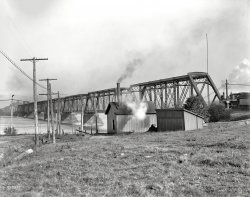
- Elephants at the Deco
- ... from Broadway onto what may be Nash St. near downtown Buffalo. If you lived in Buffalo during the 1960s or earlier you will for sure recognize the Deco ... Posted by BflJake - 01/04/2012 - 11:40am -
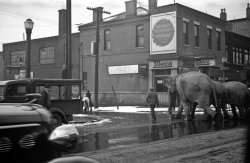
- Just Add Water: 1912
- ... The Great Lakes sidewheeler, built for the Cleveland & Buffalo Transit Co., the day before its launch at the Detroit Ship Building ... Posted by Dave - 03/09/2018 - 12:24pm -
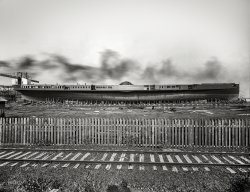
- Alaska: 1957
- ... cabinets under her kitchen sink in her 1920 Foursquare in Buffalo NY. If memory serves me correctly, she told me they were original. I ... Posted by Mountainair - 09/16/2011 - 2:12pm -
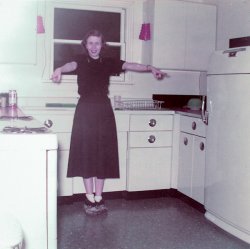
- Meskwaki Indians
- ... The man to the left is my grandfather, George Buffalo Sr. and to the right is James Ward. Both men are of the Meskwaki tribe ... Posted by Chris_C - 09/18/2011 - 10:34pm -
![Meskwaki Indians From my wife's grandfather. A group of postcards of Meskwaki Indians from the early 1900s in Tama, Iowa.
Can you date the car in this picture? They look like Kodak photos turned into postcards. All have the names of those in the photographs written on them. No other postcards have modern machinery, but a few have people dressed in "contemporary clothes" along with traditionally clothed people that discerning Shorpy-ites may be able to pin to date ranges. I will post them if there is interest. View full size.
Real Photo postcardsThere was a line of "Realphoto" postcards in the early 20th century which were actual emulsion prints, albeit black and white. They scan much better than halftone or hand-colored postcards, with real detail, like the magnificent picture here. This could be such a card, or a similar competitor. The car appears to be 1915-1920 vintage. The ceremonial outfits display excellent floral pattern beadwork or quillwork typical of the midwestern tribes and the Great Lakes region, quite a contrast to the more geometric patterns of the Plains cultures. I would certainly like to see more!
My GrandfatherThe man to the left is my grandfather, George Buffalo Sr. and to the right is James Ward. Both men are of the Meskwaki tribe in Tama, Iowa. Photographs of the "Tama Indians" were often taken during the annual pow-wow and made into postcards for resale. I'd date this photo at about 1918 - 1919 judging by my grandfather's approximate age here. Their dress is traditional Meskwaki except for the headdresses, which were gifts and of Siouan origin.
I would love to see more of the photos in your collection. I'm sure the Meskwaki Historical Preservation Department would appreciate high quality scans of your collection.
Contact:
Mary Young Bear at 641-484-3185
http://www.meskwaki.org/Historical%20Preservation.html
[You can try contacting the member directly by clicking on the member name (after "Submitted by" above the photo) and then the Contact tab on their profile. -tterrace]
(ShorpyBlog, Member Gallery)](https://www.shorpy.com/files/images/Meskwaki.thumbnail.jpg)
- Molalla Buckeroo: 1936
- ... of this Native American call to mind the profile on the buffalo nickel (1913-1938) by sculptor James Earle Fraser.
[The ... Posted by Dave - 10/27/2019 - 3:28pm -
![Molalla Buckeroo: 1936 July 4, 1936. "Warm Springs Indian at Molalla Buckeroo," the Fourth of July rodeo in Molalla, Oregon. Medium-format nitrate negative by Arthur Rothstein for the Resettlement Administration. View full size.
The final humiliationThe classic features of this Native American call to mind the profile on the buffalo nickel (1913-1938) by sculptor James Earle Fraser.
[The resemblance is rather striking, although according to Fraser the depiction is a composite rather than a specific individual. - tterrace]
(The Gallery, Arthur Rothstein, Native Americans)](https://www.shorpy.com/files/images/SHORPY_8b28018a.thumbnail.jpg)
- Laddies Who Launch: 1913
- ... sidewheeler cruise ship operated by the Cleveland and Buffalo Transit Company, or C&B -- Seeandbee, get it? Later she was ... Posted by Dave - 05/09/2019 - 1:32pm -
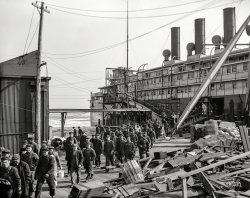
- Grandma's kitchen, c. 1910
- I believe that this was taken in Buffalo, NY about 1910. I have no idea if it is my Grandmother's kitchen or ... Posted by bhappel - 10/10/2009 - 10:30pm -
